While we were at the NEAT fair Bryn picked up an E-flite Blade mSR on my suggestion to hopefully help him learn some helicopter flying skills. Since I have it on hand I wanted to share my review of it with my readers.
I had flown the Blade mSR helicopter a couple of times before. One of our club members let Ollie and I fly his, and then Ollie bought one so I got to fly his as well and had a bit of previous experience to say this was a good buy and a good helicopter to start with. It’s a fixed pitch helicopter, so you won’t be doing a lot of stunts, but I bet you’ll be having a lot of fun.
The Rundown
The Blade mSR is a small radio controlled helicopter manufactured by Eflite, it fits into their line of micro aircraft which use a 1 cell lithium polymer battery and micro electronics and motors to obtain indoor radio controlled flight. If helicopters aren’t your thing they offer a variety of other models, and there are also other manufacturers of these type of aircraft as well.
While micro models have been around for quite a while. Very few of them were attainable to those of us who did not have insane micro-modeling skills, and even fewer of those flew particularly well, especially where helicopters are concerned. The Blade mSR totally smashes my previous vision of how a micro, ultra-micro or perhaps even nano, radio controlled helicopter should and does fly.
This little helicopter is TINY. It comes in a little under 8 inches long (20cm) and 4.7 inches tall (12cm). Very compact! Additionally it sports a 7 inch rotor span (about 18cm) which makes it small enough to fly just about anywhere. I have hovered quite a few battery packs in my crowded living room, practicing nose in hovering and just general goofing around. Enough of the fun flying experiences for now though, let’s look under the hood and see what makes this small helicopter tick.
I think one of the largest points to consider is the weight. The box says that the helicopter is 28grams. I actually weighed this one with the battery and it came in at 27 grams on my micro scale. How do you realize that in normal human terms? Well, a US Quarter is 5.6 grams so this weighs as much as $1.25 worth of quarters. Now I bet that got your attention AND that’s with the battery installed pretty good for this little blade helicopter.
The kit came with 2 E-flite LiPoly batteries and a LiPoly charger which can be powered by 4 D-sized cells, or the included 120v wall adapter which steps down to 6 volts. The included eFlite charger can handle up to four LiPoly batteries at a time and doesn’t seem to have any trouble charging the E-flite 120mAh LiPoly batteries or the VamPowerPro 160mAh LiPoly batteries we picked up.
Believe it or not this monster looking charger isn’t all that big, but it does take up a major portion of the box compared to the MSR helicopter. You can see a different angle below.
The batteries themselves weigh LESS than a quarter. As you see in the charger photos above there are 2 different size batteries. The ones in the middle are the stock EFlite batteries are a single cell Li-Poly rated at 3.7 volts nominal with 120mAh capacity. On the outside are the VamPowerPro 160mAh 3.7v nominal LiPo batteries which were purchased extra from the dealer who sold the helicopter itself. The stock E-flite 120mAh batteries weigh in at a slight 3.6 grams giving a power to weight ratio of 33mAh per gram. For an example of power capacity, at a discharge rate of 1c(1 x capacity) you could discharge the 120mAh pack at .12 amps, and it’d last about 1 hour. With these packs you can get 7-10 minute flights depending on how you fly.
The VenomPowerPro 160mAh LiPo batteries came in a little heavier, due to higher capacity, at a still lean 4.6 grams. That works out to a power to weight ratio of about 34mAh per gram.
Ok ok! I give in! Enough of the technical junk, so here’s some less technical junk. Also leading to the insanely light weight of the e-Flite Blade mSR helicopter are some other features. One of the largest is the all-in-one board, the brains of this micro electric helicopter, which contains the brushed motor controllers for the main rotor as well as the speed controller for the tail rotor, the linear servos for the rotor head and a gyro of some sort to keep the tail straight.
In the photo’s below you can see the back end of this board with the two linear servos. The white and black wires, while they may look big in the photo are pretty tiny, everything about this model is tiny, don’t let the photos fool you. You can see the arms from the rotor head link down to the linear servo modules. The servos respond pretty quickly to your remote inputs so response is no worry when you’re out flying the Blade. It mostly comes down to the speed of your thumbs and how fast you can calculate helicopter aerodynamics in your brain (it’s a learning process).
You can also see the main drive motor in those photos, and in the bottom photo you can see the power leads that run off to the tail. There’s mostly electro-mechanical components on the back of this all-in-one board, and most of the brains are on the front of the board. In the top picture, the small piece of magnet wire coming off the board is actually the antenna. The board uses a Cirrus Logic wireless 2.4 Ghz USB chip, this is also the same type of chip that Airtronics SD-10G uses, although a slightly different model number. If you’re a tech person, check out these Cirrus Logic Wireless USB chips, they are programmable so you could write your own R/C system into them.
All of this technology is used to control the main rotor head through two servos. Since this helicopter is fixed pitch it doesn’t require a 3rd servo to control pitch. You just have the left and right and fore and aft cyclic which is accomplished through the two servos on the front two points of what would be a 120/140 degree CCPM setup.
The tail rotor is pretty straight forward, it’s a DC drive brushed motor. The motor accelerates and decelerates to counter torque from the main rotor, but it doesn’t actually reverse. The little tail motor kicks in and provides a pretty decent piro rate that I don’t think you will be disappointed in.
The miniature tail rotor is powered through equally miniature tail rotor wires which you saw earlier. Here’s an extra close up shot of the tail rotor wires and how they’re wrapped around the canopy supports for the Blade mSR.
The e-Flite Blade mSR Ultra-Micro helicopter comes in two versions. You can get it as a BNF version without a transmitter that will work with your Spektrum DSM2 transmitter and also JR and any other radio transmitter which runs DSM2. Or you can pay about $20 dollars more and get the version that comes with a very basic, but suitable transmitter.
Yeah, but how durable is it?
I don’t have any super crash of doom videos of this thing (so we filmed a couple shots for you, in the video below) but needless to say I have put in quite a bit of flight time already. Below is a short video of me flying the Blade mSR indoorst. Indoor flight is a piece of cake and once you get the heli off the ground it can hover hands free for quite a few seconds. Outdoors you are a servant to the wind and this little helicopter doesn’t quite have the power you need to fly in any more than a gentle breeze. There is a larger model, the E-Flite Blade mSR 120 which is meant to fly in outdoor conditions with slight breezes.
http://www.youtube.com/watch?v=zjBb8QlDWe8
What about parts?
The model comes with a spare flybar, tail rotor, screwdriver, swashplate leveler and swash plate linkage so you have some extra parts in case you need them. while it’s possible to break other pieces, even after some bad landings and interference from freestanding objects I have yet to damage it, so I think the included parts are reasonable. You can also get spare parts for this little heli for quite reasonable prices.
Final Summary
I would highly recommend this model to anyone I ran into who wanted to try flying model helicopters without a huge investment, or for those who are expecting a long cold winter indoors. If you have forced air heating I would stay away from the vents, and ceiling fans in the summer are a definite booby trap for your little moment of joy. I believe if you buy one of these it will help stave off cabin fever and give you a few more weeks of sanity.
Bonus – Go Nightflying!
If this isn’t enough to sell you on the concept, you can buy a version of this helicopter with a glow in the dark frame. Mixed with the blue LED up front you can hover around in the bedroom in the middle of the night to get rid of those ‘need to fly’ night sweats, or when you wake up from a nightmare where you’ve just crashed you expensive heli, you can regain your confidence with this pint sized helicopter. (Not recommended for married folks, unless you’d rather just fly your helis whenever you want!)
If you’re curious about other small aircraft, I’ve just posted my review of the E-flite Beast UMX Biplane.

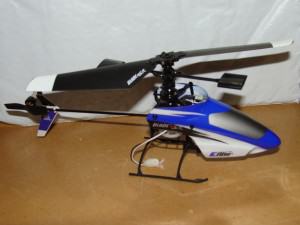
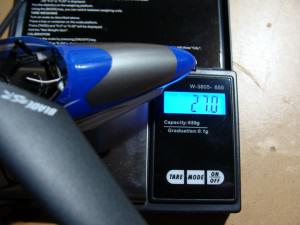
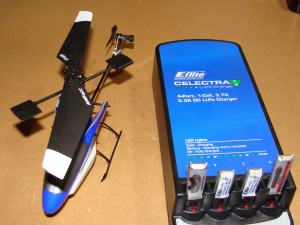
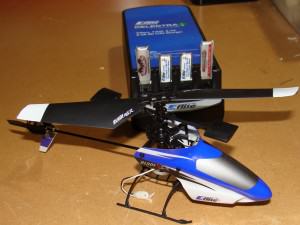
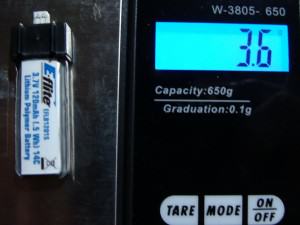
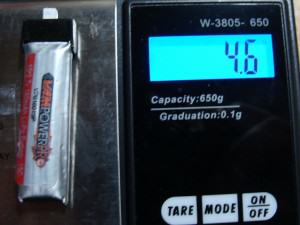
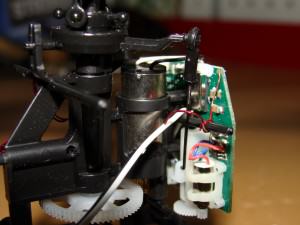
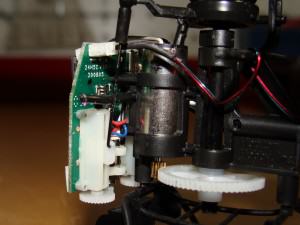
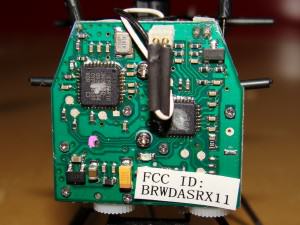
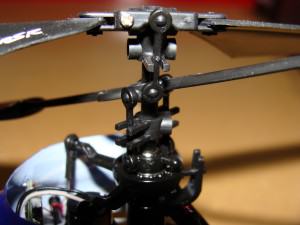
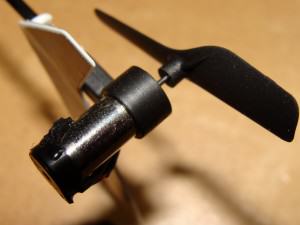
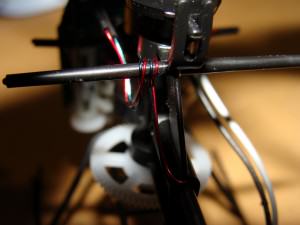
2 responses to My Blade mSR Micro Helicopter Review
Someone named Michael asked about the chips on the mSR. I did a little research. The larger 40 pin chip most represents the CYRF69103, I know it’s not the exact chip ( CYRF8910 ) on the mSR, but it should give you an idea of the capabilities of this all-in-one processor + RF.
PiperJ3 on Rcgroups.com says “Actually, the mSR does not have a gyro, it uses a solid-state integrated angular rate sensor and accelerometer fabricated on the same chip. This is why it is not necessary to stabilize the machine when it powers-up and binds. The rate sensor gets its information as the machine starts in motion.”
The second chip was harder to decode it was sanded pretty good. I could tell that it is an Atmel chip ending in an 8. After a bit more research it appears to be an ATTiny88. Which means I’ve still not located and accelerometer/gyro or other MEMS device.
On the back of the 5-in-1 board you’ll find a little silver can, here’s what you’re looking for. It appears to be a gyrostar device. While I could not find the exact part number, I did find a ‘general’ data-sheet with the pinout. The datasheet should be enough to help you get started http://www.anglia.com/murata/datasheets/GYROSTAR.pdf happy hunting!
Jon,
Although this heli looks fun, the video does show a lot of 1000 ways to die. 🙂
-xenonion-
Leave a reply to My Blade mSR Micro Helicopter Review